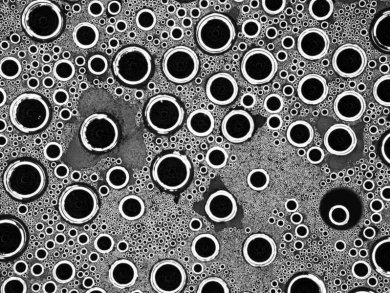When moisture impinges upon a cooler surface, individual water molecules coalesce into micron-scale droplets. While these grow, smaller ones constantly repopulate the spaces between them. They can coalesce with their larger siblings over time. Up to now, it has been assumed that the distribution of droplet sizes followed a power law. Irrespective of whether the early, middle, or late growth phase is involved, the majority of droplets are small. The larger the droplets are, the fewer of them are present.
Jürgen Vollmer and colleagues, Max Planck Institute for Dynamics and Self-Organisation, Göttingen, Germany, found by using computer simulations and experiments that one and the same law does not aptly describe the entire growth phrase of the droplets. There are many more small drops than large ones, but significantly fewer small droplets are observed than expected.
In the beginning, small droplets are widely separated and collect the precipitate especially efficiently. The water that lands in their vicinity migrates over the surface toward them, which speeds up their growth. Near the end of the growth process, there are already so many drops nearby that the neighbors absorb these “indirect hits”. In contrast, the especially large drops hardly meet any others which are larger, and so there are none to swallow them up. Consequentially, their growth slows.
These results could benefit technical applications that are based on the special properties of drops. Since droplets can absorb heat effectively, they are, for example, needed in refrigeration and air conditioning.
Image: © MPI for Dynamics and Self-Organisation
- Max Planck Gesellschaft, Munich, Germany




